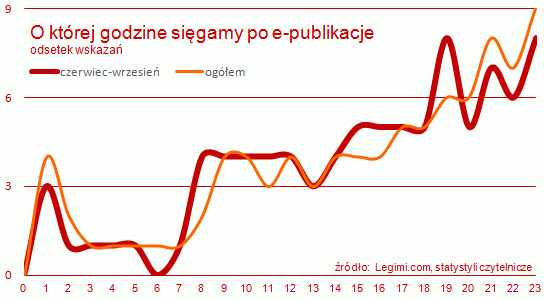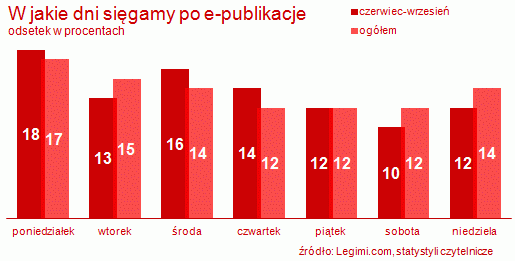
Summer shows a more evenly spread tendency to read digital publications throughout the day. However, evenings clearly dominate, especially late evenings, with a noticeably higher percentage of e-readers at the end of the day.
For Android devices, peak reading times during summer were at 2 p.m. (14% of respondents) and 9 p.m. (10%); iPad users read most around 8 a.m. and 4 p.m. (13% each), while iPhone e-book readers usually read at 9 p.m. (28%) and 1 p.m. (18%) - according to the study authors from Legimi. This indicates that smartphone users (both Android and iPhone) prefer reading during lunch and late in the evening.
Interestingly, according to analyses from the digital publications platform, e-reader owners are less predictable, reading at different times of day and night. 3% of respondents reported using their reader between 1 and 2 a.m., 5% at 9 a.m., 8% at 6 p.m., and 9% at 10 p.m. When combining results across all devices, peak reading times were in the late afternoon and evening (6 p.m. and 11 p.m. - 9% each).

One might think weekends are when we read the most. However, this isn’t true, as e-book and e-newspaper readers report otherwise. Summer weekends saw noticeably less reading than weekdays, with Monday, Tuesday, and Wednesday standing out. - This may be because popular weeklies, also available in digital editions, are released on those days - suggest the study authors.
Outside of the vacation period, Android phone or smartphone users typically read at the beginning of the week (32% on Monday, 23% on Tuesday, and only 2% on Sunday).
COMMERCIAL BREAK
New articles in section Media industry
Advertising market 2025. Poland, Europe and the World
Marcin Grządka
The global advertising market is growing by 8.8% in 2025 and will reach a value of 1.14 trillion dollars. The industry result in Europe records slightly lower dynamics, at the level of 5.8%. In this comparison, Poland performs clearly above the average. We will record an increase of 8.9% this year and a value of 18.56 billion PLN - estimates WPP Media in the annual report "This Year Next Year".
The print media market 2025. Three global trends
Krzysztof Fiedorek
The market value is 359.53 billion dollars, yet the erosion is visible to the naked eye. The decline for newspapers will amount to -2.3 percent. Despite this, print retains strength: it generates 76 percent of subscription revenues and enjoys 82 percent consumer trust. The future of the industry is defined by hybrid strategies and niche specialization.
Journalism in the age of AI. Why people prefer humans over machines
Krzysztof Fiedorek
Only 12% of people accept news created solely by AI, while 62% prefer those written by humans. At the same time, only 19% notice labels indicating the use of artificial intelligence, while younger audiences ask AI to explain the content to them. These are the findings of the Reuters Institute report on artificial intelligence in media.
See articles on a similar topic:
Pseudo-democracy and Media - A Few Reflections
Grzegorz D. Stunża
Every four years, citizens are served elections, which are certainly not free. Polls replace part of the electoral process, shaping opinions and voting preferences.
Models of Journalistic Organizations
Zenon Kuczera
An overview, operational principles, and characteristics of journalistic organizations operating in Belgium, Canada, Switzerland, and the United States.
Fake News in Poland. Challenges in Assessing Information Credibility
RINF
One in four information consumers relies on sources where verifying credibility is a significant challenge. Fake news remains a major issue, as indicated by 77% of respondents, with 51% admitting they struggle to discern truth from falsehood, according to Deloitte's *Digital Consumer Trends 2021* report.
Deepfake Blurs Truth and Falsehood. Human Perception Research
KFi
Studies indicate that only 60% of deepfake images can be correctly identified by humans. As AI begins to dominate content production, the problem of differentiation fatigue grows – users lose confidence in assessing the authenticity of information and fall into cynicism.





























